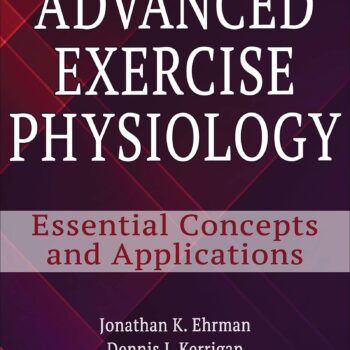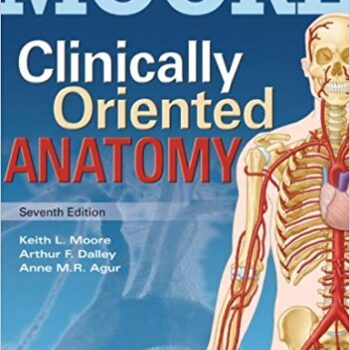
Test Bank For Anatomy & Physiology An Integrative Approach 3rd Edtion By Michael McKinley
Original price was: $55.00.$22.00Current price is: $22.00.
Digital item No Waiting Time Instant DownloadISBN-10: 1260084701 ISBN-13: 978-1260084702
Test Bank for Anatomy & Physiology: An Integrative Approach, 3rd Edition by Michael McKinley is a test bank that might help in your learning of Integrative Anatomy and makes it a little more entertaining. Designed specifically for the 3rd Edition of the textbook, this bank contains a range of question formats including multiple choice, true/ false, and short answer questions that would be asked in an exam. It’s a good practice to get accustomed to the types of questions that most likely would be set in the tests especially those targeted at biology, health sciences, and medical courses.
Features and Benefits
With the aid of the test bank, questions on key concepts in anatomy & physiology like cell, tissue, skeletal, muscular, and nervous systems can be found. Each question is developed to aid in the retention and understanding of the functions of parts, systems, and mechanisms of homeostasis. This test bank in particular comes in handy in assisting in:
- Reinforcing Key Concepts: The test bank reveals basic concepts from Michael McKinley’s textbook such as an outline of how components of the cardiovascular, respiratory, and digestive systems are complementary to each other.
- Time Management: Working with a test bank can increase one’s speed in responding to questions in an examination type of environment.
- Developed Self-Assurance: Studying through actual exam questions always aids in better self-belief and helps in reducing the anxiety experienced on the examination day.
Topics Included in The Test Bank
The test bank systematically deals with the necessary anatomy and Physiology topics in more detail. You can expect questions on:
- Skeletal Structure Overview: Basic knowledge of structures like cells, tissues, and organs.
- Organ Homeostasis: The modes of action of the circulatory system, digestive system, reproductive system, nerve system, and endocrine system.
- Nutrition and Pathology: Usual questions about common diseases by organs, and common pathologies.
- Basic Techniques: Microscopy and Dissection skills are among some of the basic tools used in many anatomy labs.
This kind of structure makes it possible for every student to grasp the practical side of the discipline, which is a turning point noted by McKinley in his system of teaching anatomy and physiology.
Why Use This Test Bank?
This will be of great assistance in any medical or health education because it strengthens the content included in the textbook by involving practical questions. So whether you are preparing for an assessment or require a review of clinical topics this test bank allows for the following:
- Comprehensive Responses: Specified answers for each question elaborated on the underlying principles of offered concepts.
- Combined Types of Questions: The Test Bank includes the use of matching types head of questions, filling gaps types of exercises, and case studies types that are practical in clinical medicine.
- Direct Application of Knowledge: Through knowledge testing on the interplay between the systems and the use of body mechanical insight, students acquire rewarding facts for nursing, medicine, and other health professions.
Summary
Michael McKinley has published the Test Bank for Anatomy & Physiology: An Integrative Approach published its 3rd Edition in the year 2011, this volume pages 55 and 123 is a miracle of swotting material, especially concerning the ‘difficult’ topics volumes inthe scope of anatomy and physiology encompass. It is used extensively by students in preparations for medical and other health-related courses as it provides correct and precise answers to some of the questions regarding the body’s major systems. With this test bank, students are less likely to be overly anxious about the test, feel more competent, and understand the right principles fully.
Test Bank For Anatomy & Physiology An Integrative Approach 3rd Edtion By Michael McKinley
Anatomy & Physiology, 3e (McKinley) Chapter 2 Atoms, Ions, and Molecules
1) Anything that has mass and occupies space is considered to be ________.
Answer: matter
Section: 02.01
Topic: Atoms and molecules
Learning Objective: 02.01.01 Define matter, and list its three forms.
Bloom’s: 1. Remember
HAPS Topic: Module C01 Atoms & molecules.
2) The three forms of matter are
A) air, water, and solids.
B) solids, liquids, and gases.
C) blood, bone, and air.
D) vapor, water, and solid.
Answer: B
Section: 02.01
Topic: Atoms and molecules
Learning Objective: 02.01.01 Define matter, and list its three forms.
Bloom’s: 1. Remember
HAPS Topic: Module C01 Atoms & molecules.
3) Which of the following has the smallest mass?
A) An electron
B) An atomic nucleus
C) A proton
D) A neutron
Answer: A
Section: 02.01
Topic: Atoms and molecules
Learning Objective: 02.01.02 Describe and differentiate among the subatomic particles that compose atoms.
Bloom’s: 2. Understand
HAPS Topic: Module C01 Atoms & molecules.
4) An atomic nucleus consists of protons and neutrons and is positively charged.
Answer: TRUE
Section: 02.01
Topic: Atoms and molecules
Learning Objective: 02.01.02 Describe and differentiate among the subatomic particles that compose atoms.
Bloom’s: 1. Remember
HAPS Topic: Module C01 Atoms & molecules.
5) Which of the following statements accurately describes electrons?
A) They are found inside the nucleus and have a positive charge.
B) They are in orbitals outside the nucleus and have a positive charge.
C) They are found inside the nucleus and have a negative charge.
D) They are in orbitals outside the nucleus and have a negative charge.
Answer: D
Section: 02.01
Topic: Atoms and molecules
Learning Objective: 02.01.02 Describe and differentiate among the subatomic particles that compose atoms.
Bloom’s: 1. Remember
HAPS Topic: Module C01 Atoms & molecules.
6) An element’s atomic number is determined by the number of ________ in one atom of that element.
A) protons
B) nuclei
C) electrons
D) neutrons
E) atomic mass units
Answer: A
Section: 02.01
Topic: Atoms and molecules
Learning Objective: 02.01.03 Explain the arrangement of elements in the periodic table based on atomic number.
Bloom’s: 1. Remember
HAPS Topic: Module C01 Atoms & molecules.
7) Within the periodic table, elements are organized consecutively by
A) atomic mass within columns.
B) atomic mass within rows.
C) atomic number within columns.
D) atomic number within rows.
Answer: D
Section: 02.01
Topic: Atoms and molecules
Learning Objective: 02.01.03 Explain the arrangement of elements in the periodic table based on atomic number.
Bloom’s: 1. Remember
HAPS Topic: Module C01 Atoms & molecules.
8) The number of neutrons in an atom can be determined by
A) subtracting the atomic number from the atomic mass.
B) subtracting the atomic mass from the atomic number.
C) adding the atomic mass to the atomic number.
D) adding the number of protons to the number of electrons.
E) adding the number of protons to the atomic number.
Answer: A
Section: 02.01
Topic: Atoms and molecules
Learning Objective: 02.01.03 Explain the arrangement of elements in the periodic table based on atomic number.
Bloom’s: 2. Understand
HAPS Topic: Module C01 Atoms & molecules.
9) When diagramming an atom, the innermost shell is filled with ________ electrons.
A) two
B) six
C) eight
D) ten
Answer: A
Section: 02.01
Topic: Atoms and molecules
Learning Objective: 02.01.04 Diagram the structure of an atom.
Bloom’s: 1. Remember
HAPS Topic: Module C01 Atoms & molecules.
10) Explain how the structure of an oxygen atom with an atomic mass of sixteen would be diagrammed. Include the number of subatomic particles in each part of the atom.
Answer: The nucleus would consist of eight protons and eight neutrons. There would be two electron shells; the innermost would contain two electrons and the outer one would hold six.
Section: 02.01
Topic: Atoms and molecules
Learning Objective: 02.01.04 Diagram the structure of an atom.
Bloom’s: 3. Apply
HAPS Topic: Module C01 Atoms & molecules.






